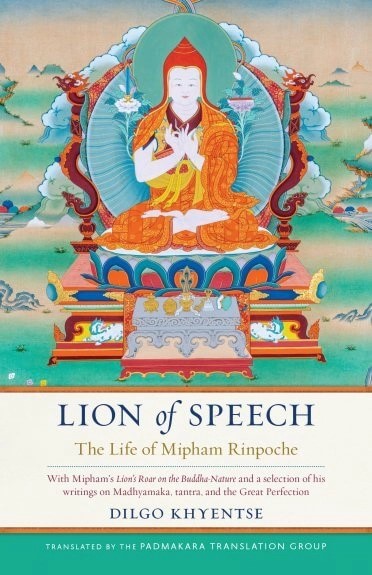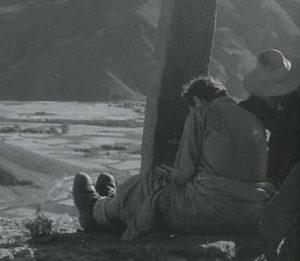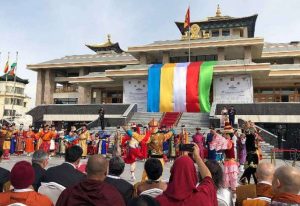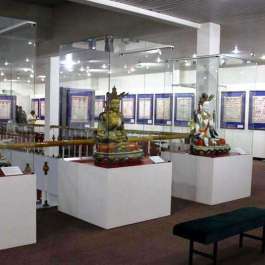
It was with delight that I recently discovered Shambhala Publication’s Lion of Speech: The Life of Mipham Rinpoche (Shambhala 2020), a biography of one of the greatest 19th century masters of Tibetan Buddhism. The volume was written by Dilgo Khyentse Rinpoche (1910–91), a revered 20th century master who taught His Holiness the Dalai Lama and numerous other important figures throughout the Himalayan region and the West. Composed in Tibet in 1939, Dilgo Khyentse Rinpoche’s work offers a rare glimpse into the life of Jamgon Mipham Rinpoche (1846–1912) as well as invaluable insights into the Nyingma school of Tibetan Buddhism and Buddhism in general.
The first half of Lion of Speech contains the first-ever English translation of Khyentse Rinpoche’s biography of Mipham. Because of its remarkable history, the biography itself is a unique treasure. Left behind in Tibet when Rinpoche went into exile in 1959, it was lost for five decades, only to be recovered by chance in 2010. In this work, Khyentse Rinpoche draws on two significant sources: oral accounts preserved in notes kept by his elder brother Shedrup Tendzin and the recollections of Lama Osel Jalu, who was Mipham’s devoted personal attendant for 37 years. In addition to the biography, the first part of the volume includes a forward by Alak Zenkar Rinpoche (b. 1943) and an introduction by the translators at Padmakara Translation Group. The significance of this work and its recent translation into English is highlighted by Zenkar Rinpoche in the following paragraph:
I believe that to translate this most precious gem, this biography so replete with meaning, into other languages will without a doubt be of service to the Doctrine. It will kindle faith and devotion in the hearts of many and will plant therein the seed of liberation. So it is with an immense joy that I received the news that the life story of this great master has been translated into English. What an excellent, what an extremely excellent, what a supremely excellent thing to do! Joining my hands before the chakra of my heart, I cast upon this book a hundred times the flowers of my joy.
(xi-xii)
Upon reading the biography, I quickly began to share Zenkar Rinpoche’s enthusiasm. Indeed, Khyentse Rinpoche puts forward a host of fascinating details about Mipham, starting from his decision to be born in 1846 into an aristocratic family that was endowed with the qualities of “power, courage, wealth, religious virtues, and respect.” (24) We are also given hints about the social and political unrest that took place in Mipham’s region—Derge Principality of Kham, eastern Tibet—during his lifetime. There is a reference, for example, to 10-year-old Mipham’s “doughty courage” in the face of an army of a thousand brigands. We learn of Mipham’s spiritual and academic journey, which included entering monastic life at the age of 12, becoming a disciple of Lab Kyabgon’s supreme spiritual son, the venerable Loter Wangpo, receiving an extensive list of transmissions from different schools of Buddhism, and spending years in retreat in the wilds of Kham. And, last but not least, Khyentse Rinpoche also provides insightful details into the circumstances surrounding Mipham’s death.
Even more impressive than this historical account is the way that Khyentse Rinpoche brings to the fore Mipham’s deep embodiment of core Buddhist concepts. In the following paragraph, for example, he offers an enchanting display of Mipham’s commitment to living by the doctrine of impermanence:
In general, Mipham Rinpoche was at all times gripped by a determination to leave samsara forever. His mind was constantly imbued with a sense of impermanence, and whenever there was something to be done on the morrow, he would say, “If I am not dead, I will do it.”
(61)
Khyentse Rinpoche also showcases Mipham’s dedication to critical thinking and to the nonsectarian movement:
So it was that, boarding the ship of an astonishing critical discernment, Mipham set sail upon the great ocean of the sacred teachings—the pitakas of the greater and lesser vehicles of the Mighty Sage and the outer and inner tantras of the Mantrayana, together with the wisdom commentaries of the numerous accomplished scholars of both India and Tibet. He repeatedly examined the views and philosophical assertions of his own and other schools, assessing the crucial points of their profound wisdom, whether specific to themselves or held in common. With the certainty of valid knowledge based on scripture and reasoning, he investigated without confusion every faulty assertion arising from mistaken ideas or simply from a lack of understanding.
(40)
Because of the focus on Mipham’s human qualities—such as his scholarly excellence and expert knowledge of meditation—Khyentse Rinpoche’s work is likely to please a wide range of contemporary readers. As for those who wish to learn more about the miraculous aspects of Mipham’s life, these are largely downplayed in the volume. Although thankfully the translators have made up for this by including a selection of Mipham’s writings with the biography. In keeping with the identification of Mipham as an emanation of Manjushri—the lion of speech—the second half of the book comprises the following works: a new translation of The Lion’s Roar: A Comprehensive Discourse on the Buddha-Nature and A Lamp to Dispel the Dark, a teaching of the Great Perfection, as well as excerpts from previously published translations of his works on madhyamaka and tantra.
Mipham’s writings are insightful and thought-provoking, yet he manages to balance intricate concepts with simple allegories that illuminate the meaning of his teachings. For example:
It is not the dharmata that is encompassed by phenomena—just as it is the sky that contains the clouds, not the clouds that contain the sky.
(179)
Keeping to this practice, you should let your consciousness rest within itself. And all by itself its nature will manifest as primordial wisdom, just like water that becomes clear when it is left to stand.
(202)
There is no question in my mind that this publication, with its rich historical context, is a treasure to behold and I would encourage anyone who wants to find out more about two of Tibet’s greatest Buddhist masters to delve right into it.
References
Khyentse, Dilgo. 2020. Lion of Speech: The Life of Mipham Rinpoche. Boulder, CO: Shambhala Publications.
Related features from Buddhistdoor Global
Poison Is Medicine: Paradox and Perception in Vajrayana Buddhism
Kyabjé Tsikey Chökling Rinpoche (1953–2020) – Tender Recollections of a Marvelous Life
Regaining Our Simplicity and Humanity: Dilgo Khyentse Yangsi Rinpoche on Practice in Modern Times
Lessons in Impermanence: A Conversation with Choje Lama Wangchuk of the Thrangu Monasteries
Khandro Dorje Phagmo Rinpoche: An Ancient Legacy Manifested
Searching For The Enlightened Vagabond: The Life And Teachings Of Patrul Rinpoche – An Interview with Matthieu Ricard












